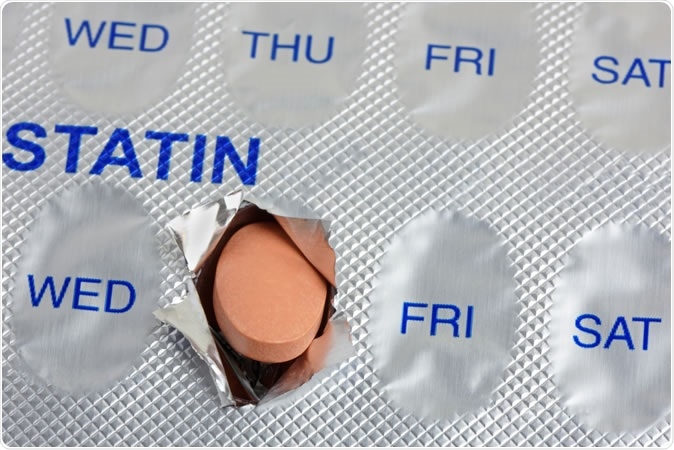Statins are lipid-lowering drugs in extremely common use in the UK and indeed, in the world. At present, most people who use statins have been prescribed these drugs for primary CVD prevention.

Image Credit: Roger Ashford / Shutterstock
Since they were introduced in the global market, statins have accounted for a major chunk of spending on medicines, with estimated sales by 2020 approaching about $1 trillion globally. The use of statins is generally appropriate in patients who have disease of the heart or blood vessels, as in strokes. However, the present study aims to answer the question as to whether they should be used to prevent the first occurrence of cardiovascular disease (CVD) - which is called primary prevention – rather than to keep it from recurring once treated (secondary prevention). Does their use for this purpose actually bring about more benefit than harm, and is it useful for society as a whole?
Changing guidelines lead to increased statin use
As European guidelines on preventing CVD changed in the period 1987 to 2016, the percentage of people thought to be potentially at benefit from the use of statins increased sharply. In the Irish study already mentioned, the percentage of people above 50 years who were prescribed statins went up from 8% to 61%. In other words, more and more people at low risk for CVD were being put on statins. Moreover, the number needed to treat (NNT), which represents the number of people that need to be treated with statins to prevent one major cardiovascular event (MACE) such as stroke or heart attack, went up in this period from 40 to 400 low-risk individuals/ case prevented. This means 399 people are taking statins to prevent one heart attack or stroke.
Do statins help in primary CVD prevention?
When the researchers looked at people taking statins without any prior history of CVD, they found three reviews, covering people aged 62-69 years on average, and on statins for 1-5 years. There was a 10% reduction in the risk of deaths from all causes, 15% reduction in risk of death due to vascular disease, 30% risk reduction in major coronary events, and 25% risk reduction in major vascular events, compared to those not on statins.
However, they also factored in the very low risk of most participants for CVD at baseline, based on their age and sex, smoking, blood lipid levels and blood pressure. When this adjusted risk reduction was calculated, it became statistically insignificant for most outcomes. A potentially confounding factor was the small number of people in each subgroup.
Absolute risk vs relative risk
When reported in terms of absolute risk reduction for low- and high-risk patients, the pattern of benefit becomes very unclear. For instance, a high risk patient with a 38% absolute risk of a major coronary event in the next 10 years would have a 24% relative risk reduction, but an absolute risk reduction of 9% compared to the general population. In other words, his risk is now 29% for a coronary event over the next decade because he is taking statins. The NNT is 11 in this case.
However, if we look at a woman with only 1.4% risk of the same outcome, the relative risk reduction is 41%, amounting to an absolute risk reduction of 0.6%. The NNT in this case is 166 – which doesn’t justify taking a daily medication to achieve such a small fraction of prevention for such an unlikely event.
Cost-benefit ratio
Thirdly, statins can cause harm. This must be weighed when deciding whether to prescribe a statin for a person at very low risk when the benefit is marginal. Some patients and doctors may want to reduce the risk, however small, and however tiny the benefit may be, but other studies show that 97% of older patients object to taking drugs if it affects their ability to cope with daily living activities, and about 50% do not wish to take a medication that causes nausea or tiredness. A recent systematic review shows that the reductions in vascular disease with statins used for primary prevention, in patients above 70 years, are insignificant.
Statins can also cause myopathy, breakdown of skeletal muscle, diabetes, and stroke. Objective data is sorely lacking to establish the true incidence of harms from these drugs for several reasons. Older patients are also more likely to be taking multiple drugs and to have multiple medical conditions, making the decision to prescribe statins a bit more complicated.
How to discuss statins with patients
Of course, cardiologists may disagree. However, the study raises important and intuitive questions, supported by sound evidence. It is important to carefully consider the value of statins in primary prevention of CVD in low-risk patients, as it may represent low-value care and unnecessary healthcare expenditure. The uncertainty about the clinical outcome in the individual patient makes it more difficult to decide when the drug is truly needed or is being overused. Patients should know the above truths about statins when they discuss these drugs with their doctors.
The authors recommend larger studies to provide sufficiently large power to clarify these aspects, making more rational prescriptions and patient discussions possible. At present, healthcare policies and guidelines should take into consideration the concept of low-value care and the need to allocate resources in accordance with the greatest cost-benefit ratio.
Journal reference:
Statins for primary prevention of cardiovascular disease. Paula Byrne, John Cullinan, and Susan M. Smith. BMJ 2019;367:l5674. doi: https://doi.org/10.1136/bmj.l5674. https://www.bmj.com/content/367/bmj.l5674